
by Julia Rosen Tuesday, July 7, 2015
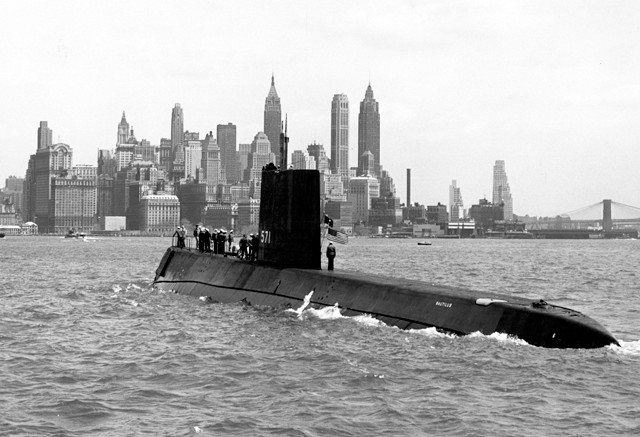
The USS Nautilus entering New York Harbor in May 1956, two years before its famous voyage to the North Pole. Credit: Library of Congress.
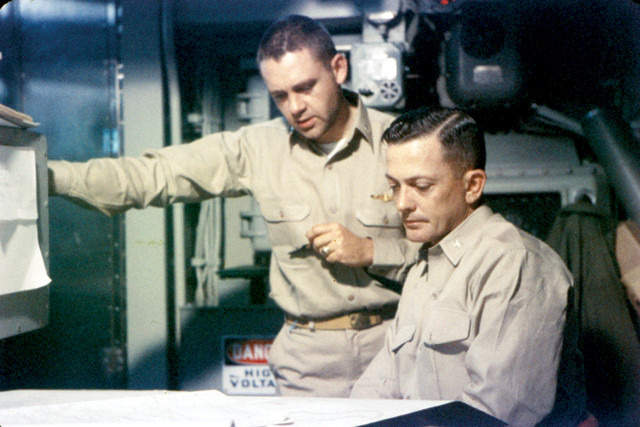
Cmdr. William Anderson (seated) and navigator Lt. Shep Jenks (standing) confer aboard the USS Nautilus during its transpolar voyage in 1958. Credit: U.S. Navy.
As the USS Nautilus glided through the black depths of the Arctic Ocean, Cmdr. William Anderson asked the crew for quiet. A tense silence hung over the dull roar of the propellers and the sharp pings of sonar as the submarine closed in on its destination. “Eight … six … four,” Williams counted down over the intercom, accelerating as they got closer, “three … two … one …”
Aside from Anderson, no one would have anticipated the moment the submarine hit its mark more than Waldo Lyon, the chief scientist of Operation Sunshine and one of 116 men aboard the Nautilus on Aug. 3, 1958. Lyon had spent the past decade spearheading efforts to send a submarine beneath the polar ice cap, and his work was about to pay off. “Mark!” Anderson barked triumphantly into the handset. “For the USA and the U.S. Navy: the North Pole,” he declared.
In that moment, the Nautilus, the world’s first nuclear-powered submarine, achieved a significant Cold War victory: It became the first ship to sail to the pole, a feat that had eluded ships cutting through surface ice. But the submarine’s historic trans-Arctic voyage did more than rally patriotic pride. It provided the first glimpse into the uncharted expanse of the Arctic, and in doing so, opened a new ocean to science.
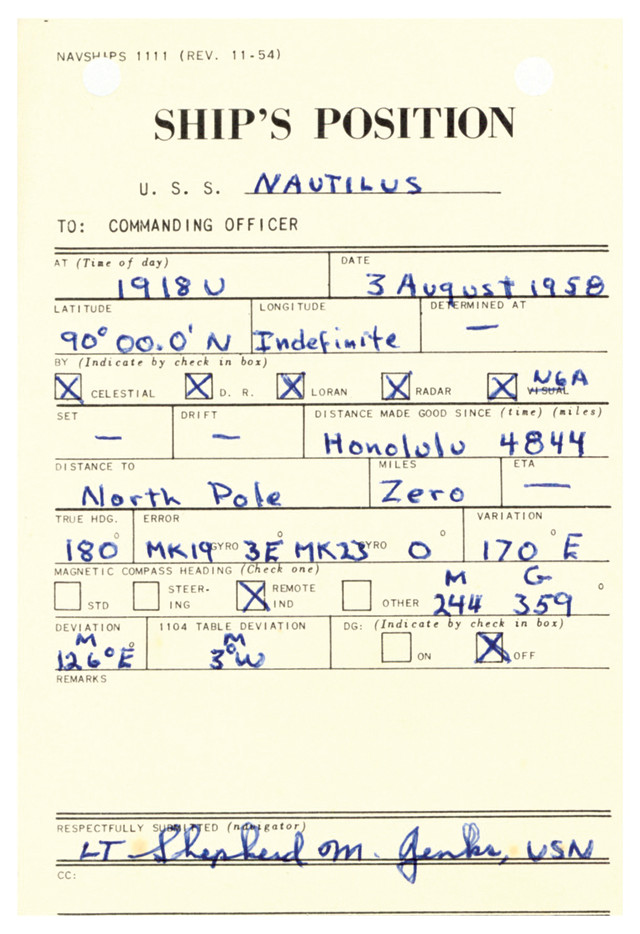
The original ship's position report, filled out by Nautilus' navigator Lt. Shep Jenks in blue ink, was later rewritten in official black ink. Jenks kept this copy until his death in 2014, after which his son donated it to the U.S. Navy Submarine Force Museum in Groton, Conn. Credit: U.S. Navy.
The Nautilus was not the first U.S. Navy ship to bear the name of the fictional submarine from Jules Verne’s 1870 novel “20,000 Leagues Under the Sea,” (there have been six) nor was it the first named Nautilus to seek the North Pole. That distinction belongs to a submarine built in 1916 by the Navy and later used by Australian polar explorer Sir Hubert Wilkins and Norwegian oceanographer Harald Sverdrup.
The earlier Nautilus made just one short dive beneath the edge of the Arctic sea ice in 1931 before suffering irreparable damage on the voyage (it was intentionally sunk in a fjord not long after its return to Bergen, Norway). But the expedition did improve scientists’ limited understanding of the polar ocean, where Sverdrup’s soundings revealed depths of more than 3,600 meters — the limit of his instrument. (This achievement earned the Nautilus a place on the map; one of the Arctic Ocean’s sub-basins bears the vessel’s name.)
More than a decade after the first Nautilus expedition, Waldo Lyon began considering what it would take to operate a submarine under polar ice. As an engineer at the U.S. Navy Electronics Laboratory in San Diego, Lyon developed sonar systems that could work in cold, salty water and studied the properties of sea ice to determine whether submarines could surface through pack ice. He also realized that boats navigating beneath the ice would need tools to gauge ice thickness, so his team invented an upward-facing acoustic profiler.
Lyon, who had earned a doctorate in physics from UCLA in 1941, tested his technologies on several expeditions in the late 1940s and 1950s beneath the sea ice in Antarctica and around the Bering Sea. But despite his progress, it remained too risky for a conventional diesel-powered submarine, which needed to surface periodically to replenish oxygen, to traverse beneath hundreds of kilometers of ice. This changed, however, with the advent of the world’s first nuclear-powered submarine, the USS Nautilus.
Congress commissioned its construction in 1951, and President Harry Truman personally laid the boat’s keel in place in a shipyard in Groton, Conn., the following summer. Jet black and sleek as a torpedo, wearing its sail like a top hat, the Nautilus stretched nearly 100 meters long and displaced more than 3,700 metric tons of water when fully submerged. It set sail, transmitting the message, “Underway on nuclear power,” on Jan. 17, 1955.
Nautilus could sail faster and stay submerged longer than any boat before it. Unlike earlier diesel submarines, its nuclear engine didn’t consume oxygen while burning fuel. And with the seemingly limitless electricity provided by the reactor, it could produce new supplies of breathing oxygen by desalinization and electrolysis of seawater. Only the limits of its pantry — and the crew’s patience — constrained how long the submarine could lurk in the depths of the sea. At last, the final barrier to the pole had been lifted.
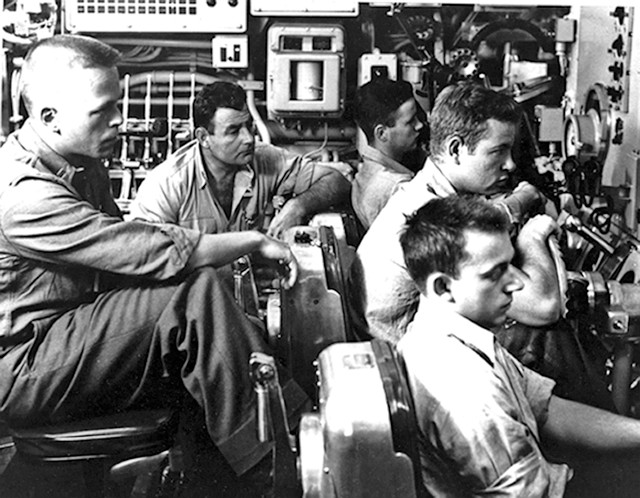
he crew aboard the USS Nautilus during its transpolar voyage in 1958. Credit: U.S. Navy.
It wasn’t only Lyon whose thoughts had turned north. Anderson had also started dreaming of the Arctic, as soon as he learned he would captain the Nautilus. Anderson assumed command in June 1957, at a celebration in Seattle where the Nautilus made a grand entrance, exploding out of Puget Sound “like an unleashed whale,” Anderson later wrote in his book, “The Ice Diaries.” It thrilled the crowd and marked the submarine’s second turn in the limelight in recent months; the first came in February 1957, when the ship sailed past the 60,000-nautical-mile mark (equivalent to 20,000 leagues) — surpassing the feat of its fictional namesake.
From that point onward, however, Nautilus’ operations would become more covert. After the ceremony in Seattle, the boat sailed back to the Navy’s submarine base in Connecticut, and then on to the North Atlantic. Here, the ship participated in a NATO training exercise simulating a Soviet attack — Operation Strikeback — along with hundreds of other ships and aircraft. While there, Nautilus dove beneath the Arctic ice for the first time.
The ship ventured under the ice edge near Greenland, but soon suffered problems with its navigation systems. The crew had correctly anticipated that conventional compasses would fail so close to the magnetic pole, but both gyrocompasses — which rely instead on the rotation of Earth — also malfunctioned. The Nautilus turned back at 87 degrees north, just 290 kilometers shy of the pole.
A few short weeks after the boat returned home, on Oct. 4, 1957, the Soviet Union successfully launched Sputnik, the first artificial satellite, and the quest for the pole was quickly elevated to an urgent national priority. President Eisenhower needed a response to Sputnik — and he needed one that carried the same weight as the satellite’s launch had. Not only had the Soviets gained an edge in the space race, they had demonstrated that they possessed the capability to launch an intercontinental ballistic missile. Operation Sunshine offered a similar double meaning; it would demonstrate the U.S.’s superior submarine capabilities, and it would flaunt that power near Soviet territory.
So on June 9, 1958, Nautilus left Seattle to return to the Atlantic. However, instead of making for the Panama Canal, it headed north and ducked under the ice in the Chukchi Sea. This time, the submarine came equipped with a state-of-the-art inertial navigation system. It employed highly sensitive accelerometers, gyroscopes and a computer that was programmed by punch-tape before leaving port and required no external reference points once underway. However, the boat encountered unexpectedly deep ice and, without accurate charts of the seafloor, almost got trapped in shallow water, forcing the ship and crew to decamp to Pearl Harbor.
Finally, on July 23, Nautilus headed north for the third time. On this attempt, the ship dove straight off Point Barrow, Alaska, entering a deep underwater canyon. From there, it sailed straight and fast to the North Pole, which it reached on Aug. 3, 1958, at 11:15 p.m. Eastern time. Two days later — and 3,000 kilometers from where it last saw daylight — Nautilus surfaced between Greenland and Norway. Just hours after that, Cmdr. Anderson was delivered to Washington, D.C., by way of military aircraft, to shake Eisenhower’s hand in front of the press.
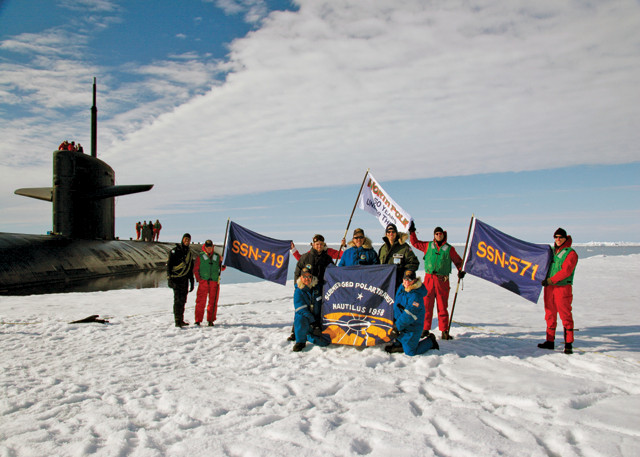
In 2008, in honor of the 50th anniversary of the first crossing of the North Pole by a ship — accomplished by the USS Nautilus (SSN- 571) on Aug. 3, 1958 — the USS Providence (SSN-719) surfaced at the pole. Credit: U.S. Navy.
The true magnitude of the Nautilus’ accomplishments would not become apparent until researchers got hold of the data the ship had collected as it traversed the Arctic Ocean. Instruments on board collected profiles of Arctic sea-ice depth and seafloor topography, the first complete transects of each. Augmented by observations from the USS Skate, another nuclear submarine poking around beneath the Arctic ice in the summer of 1958, and subsequent cruises, these data allowed researchers to start making sense of this vast unknown region.
The first scientific results of Nautilus’ expedition were contained in a 1961 paper on the structure of the Arctic Ocean basin by a pair of Lyon’s colleagues at the U.S. Navy Electronics Laboratory, Robert Dietz and George Shumway. They combined Nautilus’ new data with previous interpretations of Arctic bathymetry inferred from nearshore features, isolated soundings and the voyage of Fridtjof Nansen, who intentionally froze his ship, the Fram, into the pack ice in 1904 and made measurements as it drifted. (Much of the early sounding work had been carried out by Soviet scientists, who had studied the Arctic in great detail.)
As Dietz and Shumway noted, Nautilus’ track was “oriented favorably for geomorphic reconnaissance,” since it crossed the major features of the Arctic Ocean more or less perpendicularly. The Nautilus confirmed the existence of three major ridges that bisected the Arctic Ocean, the previously recognized Central Arctic Rise (now known as the Alpha Ridge), the Lomonosov Ridge, and “a region of seamounts” that the scientists correctly suspected was the continuation of the Mid-Atlantic Ridge (now known as the Gakkel Ridge). In between the ridges lay the deep-sea basins of the Arctic: the Canada Basin, which lies just off the shore of North America; the Central Arctic Basin (now known as the Makarov Basin); and the Eurasian Basin, itself composed of the smaller Fram, Nansen and Nautilus basins.
Dietz and Shumway also determined that the Arctic exceeded 5,000 meters depth in places. There had been an ongoing debate over whether the Arctic was underlain by sunken continental crust or if it constituted a true ocean. With the theory of plate tectonics still in its infancy, both seemed equally likely. But bolstered by Nautilus’ data, Dietz and Shumway concluded that its great depths made it a true ocean.
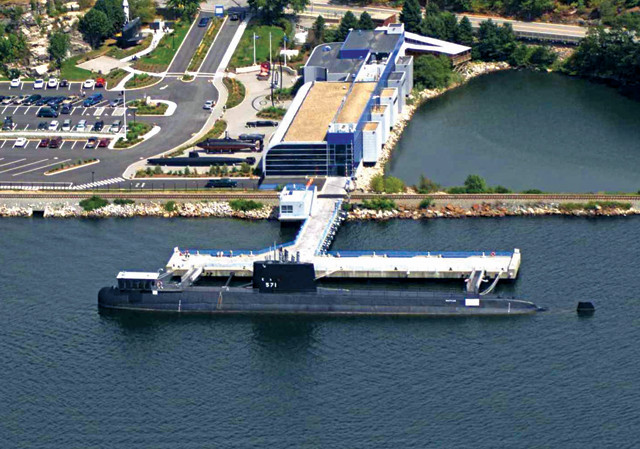
Today, the world's first nuclear-powered submarine, the USS Nautilus, is on exhibit and open to the public at the U.S. Navy's Submarine Force Museum on the Thames River in Groton, Conn. Credit: U.S. Navy.
Perhaps even more valuable than documenting the bathymetry, which is fixed and could be remeasured, was the information Nautilus collected on the nature of the Arctic ice pack. Although few realized it at the time, the region was in for dramatic change over the coming decades, and having baseline data from 1958 would prove an important benchmark.
The data were so useful that, in 1988, Alfred McLaren of the University of Colorado at Boulder painstakingly digitized more than 2 million ice-depth measurements collected along the submarine’s route. McLaren found that, on average, the ice protruded almost 3.7 meters below the sea surface, although the keels of some deformed ice plunged more than 30 meters deep. The data also revealed that the ice grew thicker from west to east, with the most multiyear ice clustered north of Greenland. As physical changes in the Arctic became harder to ignore, other researchers began to compare the sea-ice thicknesses documented during the voyage of the Nautilus and other early submarine expeditions with modern conditions, also documented by submarines as part of the Scientific Ice Expeditions, or SCICEX. In 1999, a group of researchers led by Drew Rothrock of the University of Washington found that Arctic sea ice had thinned, on average, about 1.3 meters by the 1990s.
In 2004, the same team found that these changes resulted from a dramatic increase in the amount of first-year ice and a corresponding loss of thick, multiyear ice over the same time period. In total, this equated to a 32 percent decrease in Arctic sea-ice volume. While some of these changes may have stemmed from natural climate variations, which pushed more sea ice south through the Fram Strait between Greenland and the Norwegian island of Svalbard, the researchers wrote that warming likely played an important role in the decline, a hypothesis now supported by more than 35 years of satellite observations.
That Nautilus’ data would one day help scientists understand the effects of climate change on the Arctic, or that it would uncover the location of a major mid-ocean spreading center, probably did not occur to the men onboard the ship as it crossed the pole in 1958. They knew the feat would go down in the history books as a geopolitical victory for the U.S., but their efforts also helped lay the foundations of polar oceanography.
The ship too had a legacy that lasted long after its propeller stopped turning. Having successfully ushered in the era of nuclear submarines, the USS Nautilus was decommissioned in 1980. The ship was then designated a National Historic Landmark and in 1986, it opened to the public as an exhibit at the Submarine Force Museum in Groton, Conn., where it remains to this day.
© 2008-2021. All rights reserved. Any copying, redistribution or retransmission of any of the contents of this service without the expressed written permission of the American Geosciences Institute is expressly prohibited. Click here for all copyright requests.